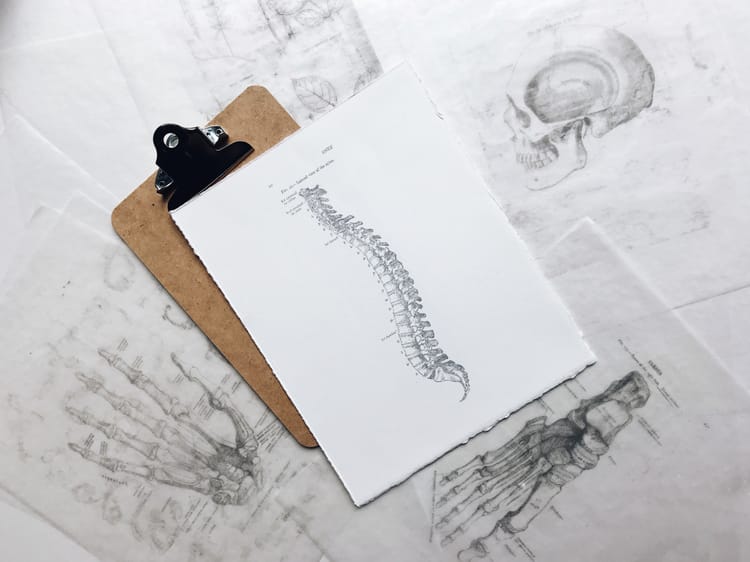Is Your Posture Really that Important? What You Need To Know
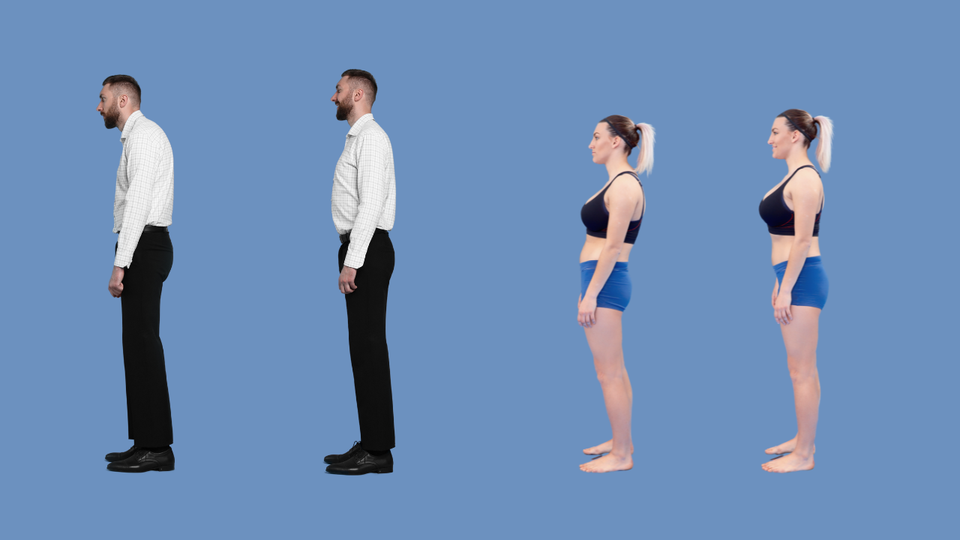
You probably grew up hearing reminders to "sit up straight" or "pull your shoulders back," but posture is far more than an aesthetic concern. In fact, it plays a significant role in your physical, emotional, and mental wellbeing.
[A quick bit of research for my fellow nerds}
What Does the Research Say?
- Posture Influences Mood & Mental State
Studies show that sitting upright boosts pride and mood, while slumped posture increases fatigue and low mood[1].
In mild to moderate depression, upright sitting enhanced mood and reduced fatigue[2]. - Better Posture Enhances Cognition & Focus
Upright posture has been linked to improved concentration and performance on tasks[3]. This is very valuable data in support of posture-focused workplace wellbeing initiatives. - Tech Neck Is a Real Problem
Forward head posture leads to neck pain, headaches, and even spinal imbalance — 30% of young workers take sick leave due to neck issues[4].
Forward head posture also alters brainwave patterns, increasing frontal-parietal strain[5]. Meaning, it can take more effort to make decisions and process body position, balance, and visual focus. - Ever-Present Postural Distortions
Conditions like rounded shoulders and hyperkyphosis affect up to 70% of adults and can reduce lung capacity, confidence, and increase pain[6].
In fact, research shows that poor posture - particularly forward head posture or “tech neck”- is associated with:
- Low mood and reduced confidence[7]
- Increased muscle tension and fatigue
- Poor focus and mental fog[3]
- Shallow breathing and reduced oxygen intake[8]
- Decreased balance and coordination
Research shows clear links between posture, brain health, pain, tension, breathing and balance- emphasising why posture should be a priority for everyone. Your posture is part of your well-being.
So what is good posture and what is bad posture?
It may sound basic, but defining posture is a key first step. At Zenith Osteopathy + Wellness, we take a comprehensive, integrative view.
Posture isn’t about a single “perfect” position. Each body is different due to so many factors including genetics and past medical history. Hence why there is no 'perfect' posture. It’s a dynamic interplay of:
- Spinal alignment
- Muscle tone and coordination
- Habitual movement patterns
- Neurological control
The goal is to optimize your posture so that the forces on your body are balanced, and there is no undue stress on structures and their function due to gravity and long-term habits.
So we consider:
- Are your postural muscles strong enough to hold you up against gravity all day?
- Where is gravity winning against your structure and neurology?
- What postural habits has the weight of gravity introduced to your structure?
- How are your lifestyle and habits keeping you in certain postures?
This is because gravity and spinal mechanics are closely related, and your lifestyle and neurological habits are linked too. In forward head posture, for instance, there is 7 times more force through your neck, compared to an optimised posture. When seated, there is 12 times more pressure going through your spinal discs compared to standing.
What does this tell us? Posture and position matter!
The Most Common Postural Challenges Today
Postural issues are widespread and can contribute to a range of problems:
1) Forward Head Posture (Tech Neck)
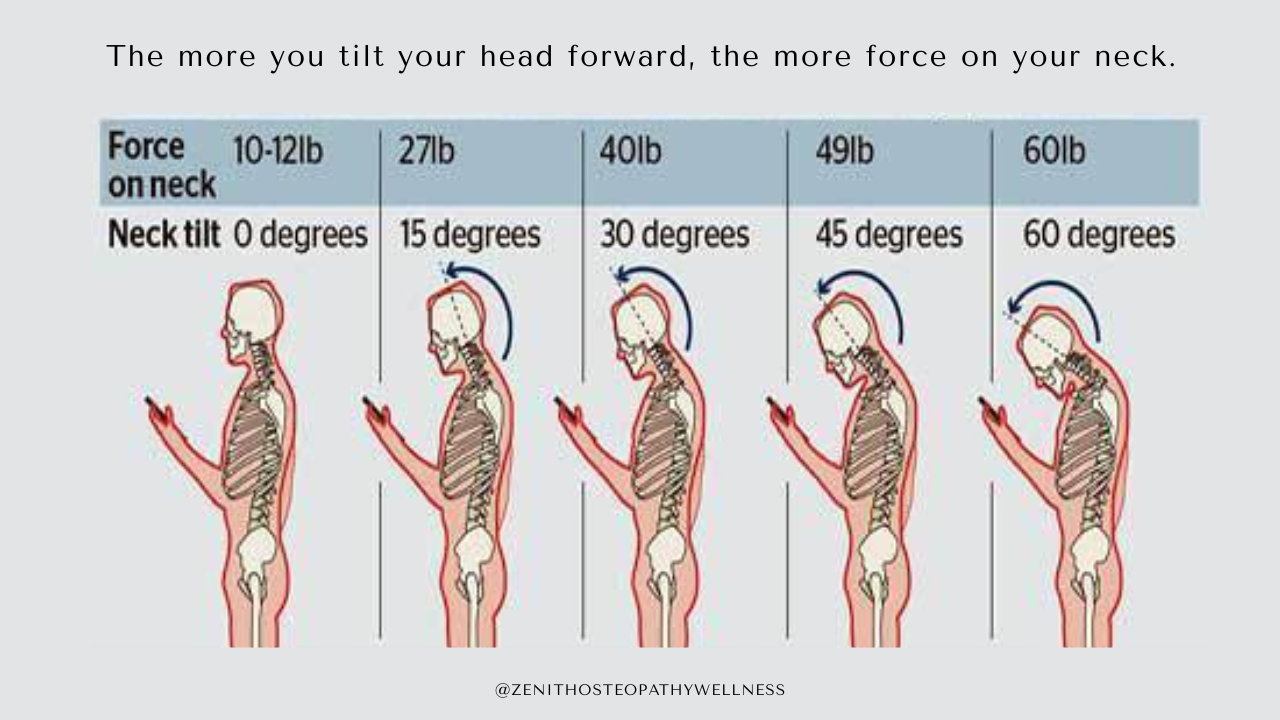
2) Rounded shoulders and upper back tension (Hyperkyphosis)
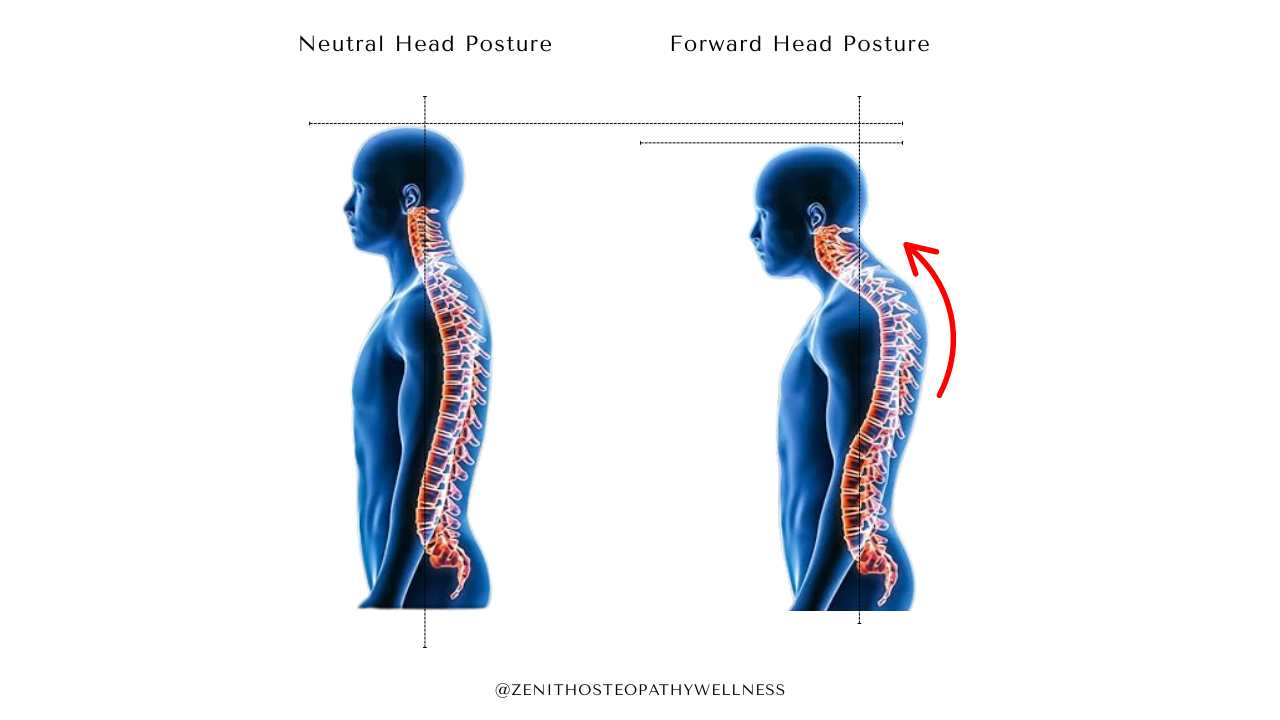
3) Pelvic tilts
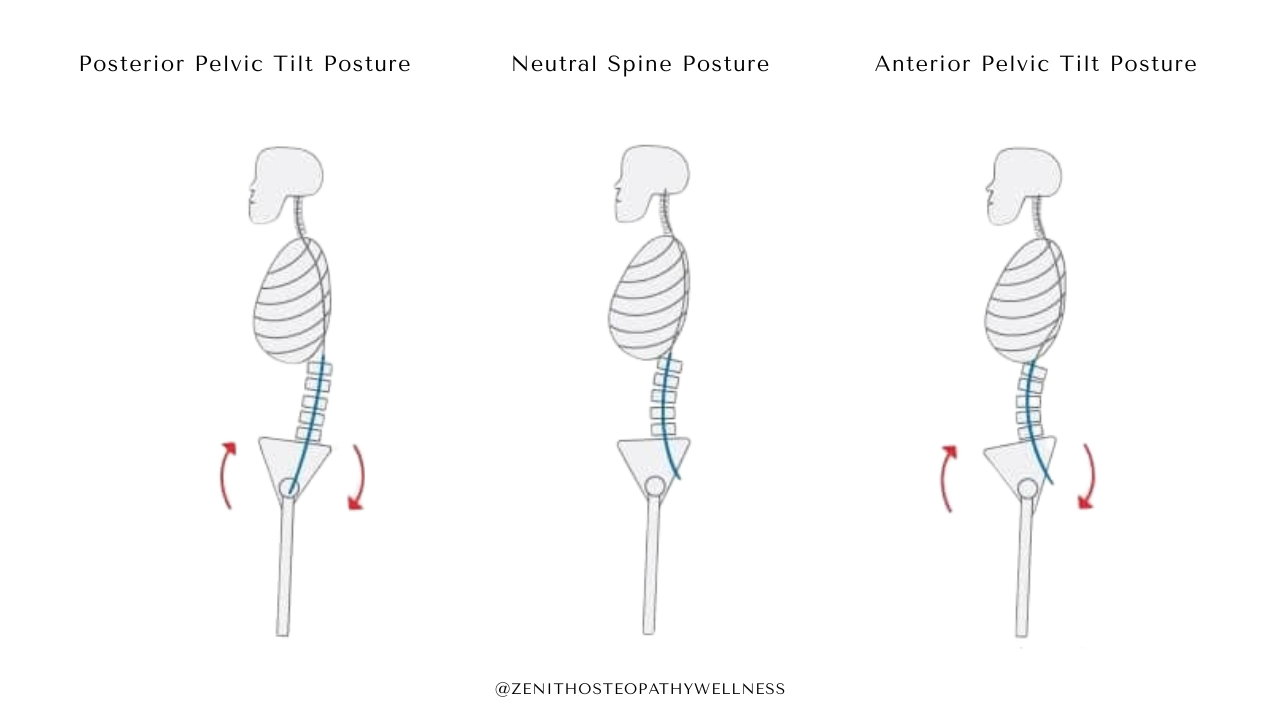
These patterns often develop from daily habits and can lead to chronic tension, discomfort, headaches, balance challenges, and even affect mood and concentration. Research shows clear links between postural dysfunction and brain-body health.
Our brains adapt and rewire based on what we do regularly — a concept called neuroplasticity. This means that, with consistent, mindful effort, you can improve your posture and reduce pain by developing new movement habits and strengthening postural muscles.
Real vs Active Posture
A common question I hear is 'How do I know if I have good or bad posture?'. It is a valid question, because often we don't notice the positioning of our bodies throughout the day.
Let's break it down:
Active Posture: when you hold yourself upright consciously.
This is often by using the bigger, more superficial muscles to stand or sit ''correctly''.
These muscles are phasic, meaning they’re designed for strong contraction. They’re not built for long-term posture support against gravity, so trying to maintain perfect posture all day quickly leads to fatigue and sometimes even pain and tension.
Think: if someone told you to “sit up straight” — how long before you start to feel sore? How long would you actually be able to hold it for?
It's because these muscles aren't designed for postural endurance.
Real Posture: your default, relaxed posture
This is how your body holds itself when you're not trying. It relies on your postural (anti-gravity) muscles, which are deeper, and more endurance based. These muscles are inherently active and function somewhat involuntarily, with support from your nervous system. Their internal muscle structure and wiring are different to phasic muscles.
Your real posture reflects and dictates your neuromuscular patterns, spinal mechanics, and habitual movement over time. It's how you hold yourself most of the time- the posture people see when you're not thinking about it. It’s also the one that affects your all the factors w mentioned at the beginning of this post: mood, concentration, breathing, pain, tension and performance
The goal is to improve your real posture
Posture Is More Than a Checklist
Posture is often reduced to a checklist of dos and don’ts:
“Sit up straight.”
“Don’t slouch.”
“Shoulders back.”
At Zenith Osteopathy + Wellness we know and believe posture is more than just how you sit or stand. It’s a reflection of how your body, brain, and lifestyle interact. It’s both a result and a driver of your overall well-being.
Posture is not just about reminding yourself to “sit up straight” or “pull your shoulders back.” At Zenith Osteopathy + Wellness, we see posture as a reflection of your body, brain, and lifestyle. It’s both a result and a driver of your overall well-being.
We believe posture can be improved through three key components:
- Spinal Alignment
- Posture Rehabilitation
- Posture Habit Re-education
✅ Your posture is a habit
✅ Your posture is dependent on your spinal mechanics
✅ Your posture can absolutely be retrained
💡3 Practical Tools to Improve Your Posture TODAY
1) Take Regular Movement Breaks
Stand, stretch tall, and move- often. This activates important postural muscles and resets tension patterns. Even 60 seconds every hour can make a difference.
2) Rework Your Workstation
Adjust your screen to eye level, keep both feet flat when you can, and alternate between sitting and standing. Ergonomic tweaks reduce stress on your neck, shoulders, and spine.
3) Increase Movement Complexity
Breathing isn’t just for stress. Deep diaphragmatic breathing enhances core stability, activates the calming part of your nervous system, and supports an upright spine. Shallow chest breathing is often a hidden driver of slouched posture. Try 3–5 minutes of slow, deep belly breathing twice per day. Inhale through the nose for 4 counts, exhale for 6–8 counts.
Our brains and bodies adapt and rewire based on what we do regularly — a concept called neuroplasticity. This means that, with consistent, mindful effort, you can improve your posture and reduce pain by developing new movement habits and strengthening control.
Optimising posture is one of the most under-utilised ways to improve mood, reduce pain, support long-term well-being and increase performance.
Want to Go Deeper?
Join the online Feel-Good Posture Workshop
If this post sparked some "aha" moments, imagine what could shift with the right support, tools, and expert guidance.

In this practical workshop, you will learn:
✔️ What posture really is (and why it’s not what you think)
✔️ Why your body feels stiff or tense by the end of the day
✔️ The truth about “tech neck” and how to manage screen-based strain
✔️ Everyday posture strategies that fit real life—working, parenting, moving
✔️ Simple, feel-good resets you can start using right away
Whether you sit at a desk all day, are active but want to improve posture, or just want practical, science-backed tools to support your body, this session is for you.
Author:
Lolitaire Healey is a Registered Osteopath and Health Coach dedicated to helping busy professionals and parents relieve pain, reduce stress and achieve sustainable well-being through personalised, integrative, trauma-informed care.
References
- Nair S, Sagar M, Sollers J, et al. The Effect of Upright and Slouched Postures on the Intrinsic Brain Activity: A Resting State fMRI Study. Brain Sci. 2020;10(12):969. https://doi.org/10.3390/brainsci10120969
- Wilkes C, Kydd R, Sagar M, et al. Posture as a Moderator of Mood and Self-Evaluations in Mild to Moderate Depression. Psychol Psychother. 2017;90(3):302–315.
- Peper E, Harvey R, Hamiel D. How Posture Affects Memory Recall and Brain Activation. NeuroRegulation. 2017;4(1):5–10. https://doi.org/10.15540/nr.4.1.5
- Shwanke T, Leaver A, Maher C, et al. The Relationship Between Forward Head Posture and Non-Specific Neck Pain: A Systematic Review and Meta-Analysis. BMC Musculoskelet Disord. 2023;24(1):384.
- Lee J, Han J, Yoon J. Effect of Forward Head Posture on Brainwaves. J Phys Ther Sci. 2015;27(4):1031–1033.
- Nejati P, Lotfian S, Moezy A, Nejati M. The Relationship of Forward Head Posture and Rounded Shoulders with Neck Pain in Iranian Office Workers. Med J Islam Repub Iran. 2014;28:26.
- Veenstra L, Schneider I, Koole S. Embodied Mood Regulation: The Impact of Body Posture on Mood Recovery, Negative Thoughts, and Self-Evaluations After Negative Mood Induction. Cogn Emot. 2017;31(7):1361–1376.
- Koseki T, Kakizaki F, Hayashi S, et al. Relationship Between Head Posture and Respiratory Functions in Healthy Young Adults. J Phys Ther Sci. 2019;31(1):63–66.

